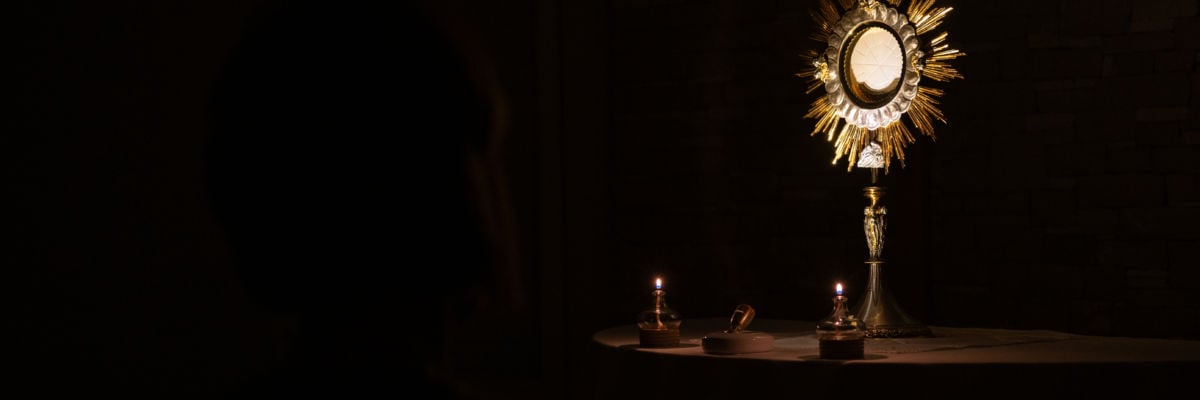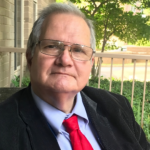
From its earliest days, the Church celebrated the Eucharist. It was the Church’s Sunday liturgy. (It is telling that it took until the 1500s for Protestant Reformers to displace the Sunday Eucharist with “Word services,” Bible reading, and preaching that marginalized the Eucharist into a monthly or even quarterly act.)
But very early on, the Church also realized that the Eucharist was a unique sacrament. A physical reality remained. Early in its history, the Church also began to save, or “reserve,” some of the eucharistic species to provide Communion to those who were dying. Communion in that case is called viaticum—food for the journey. The instrument in which the reserved sacrament was kept eventually became what we today call the tabernacle, embellished and more ornate (in keeping with the dignity of its contents) once Christian persecution was over and stability after the collapse of the Western Roman Empire was restored.
Gradually, this reservation of the Eucharist inspired devotion to the eucharistic Lord. In the early thirteenth century St. Juliana, a nun in the Augustinian order who had cultivated such devotion from her youth, is said to have had a vision in which she beheld a full moon that had one dark spot on it, which she understood to be the absence of a feast of devotion to the eucharistic Lord. She pursued the matter with the bishop of Liège, who instituted the feast locally. Eventually, that local Church pressed the issue with the Holy See, which, under Pope Urban IV, extended the feast to the entire Church.
The Solemnity of the Body and Blood of Christ, also known as Corpus Christi, was set for the Thursday after Trinity Sunday. Thursday was chosen to link it to the day of the week when the Eucharist was instituted. Since the overall ethos of Holy Thursday is dominated by the passion, death, and resurrection of Christ, a separate feast focused on the Eucharist itself as sacrament was warranted. Today, various bishops’ conferences (like the United States) have received permission to transfer that solemnity to the following Sunday.
Worship of the real presence of Christ in the Eucharist continued to grow after institution of Corpus Christi. Early on, Corpus Christi came to be celebrated with eucharistic processions, with the Eucharist displayed in a special instrument allowing it to be carried—the monstrance or ostensorium.
Eucharistic adoration was not always tied to processions. Adoration in its most basic form can take place any time by praying before the closed tabernacle, once called “a visit to the Blessed Sacrament.” Gradually, devotions allowing for the display of the Blessed Sacrament emerged. “Exposition and Benediction of the Blessed Sacrament” allowed the Eucharist to be displayed for adoration, followed by a rite of return to the tabernacle following the blessing of the people with the sacrament. As the Renaissance wore on, marked by Protestant marginalization of the Eucharist and a number of pandemics, exposition developed into the “40 Hours Devotion,” an extended exposition of the Blessed Sacrament for adoration by the faithful over a period roughly equivalent to the time Christ spent in the tomb, from his death to his resurrection. By the late nineteenth century, exposition of the Blessed Sacrament was incorporated into local, regional, and even national congresses, where pilgrimage, prayer, and spiritual conferences and exercises were combined.
In the twentieth century, especially before Vatican II, many parishes celebrated vespers on Sundays, combining exposition of the Blessed Sacrament with prayer (sometimes even the Church’s Liturgy of the Hours for the evening). Others combined exposition with an hour’s worth of prayer, silent meditation, and perhaps a short sermon—a “Holy Hour,” invoking the model of the apostles’ keeping watch with Jesus in the Garden of Gethsemane. The development of First Friday (tied to the seventeenth-century emergence of devotion to the Sacred Heart) and First Saturday (tied to the Fatima promises) fostered “nocturnal adoration,” where the Blessed Sacrament was exposed in one church from Friday night to Saturday morning, often with different parishes dividing up periods of adoration through the night.
Because these various forms of devotion emerged separately and over centuries, systematic codification of their forms and celebration took time. Arguably, the first such systematic collation was the 1973 Vatican document “Holy Communion and Worship of the Eucharist Outside Mass.” An updated version, “Holy Communion and Worship of the Eucharistic Mystery Outside Mass,” was promulgated in 2024. The document contains rites for administration of Holy Communion outside Mass (e.g., where a priest is unavailable to celebrate Mass), viaticum, exposition and benediction of the Blessed Sacrament, and eucharistic processions.
A key point of Vatican II’s eucharistic theology is that the center of eucharistic worship is the celebration of Mass. It is the full, active, and conscious participation of the faithful in the celebration of the Eucharist that occupies pride of place in Catholic eucharistic worship.
The centrality of the Mass does not exclude worship of the Eucharist outside Mass, provided that the latter does not come to detract from the primacy of the eucharistic celebration itself. Worship of the Eucharist outside Mass should lead the faithful back to a deeper appreciation of the Mass, which reaches its summit in Communion. As long as that perspective is maintained, the development of forms of worship and adoration of the Eucharist outside Mass should enrich and complement our deeper celebration of Mass. As noted above, the Eucharist is a unique sacrament because its physical embodiment persists after Mass, allowing for adoration. I emphasize that element because there were Protestant theologies of the Eucharist who considered Christ’s “presence” to remain only as long as the Sunday celebration was taking place.
The American bishops launched a multi-year national eucharistic renewal in 2022 because they were concerned that many Catholics had lost an understanding of the enduring real presence of Christ in the sacramental species. To reinforce that faith, they promoted catechesis as well as eucharistic worship and adoration at the parish level, culminating in a National Eucharistic Conference last July in Indianapolis.
(For those interested in worship of the Eucharist outside Mass and a commentary on the 2024 document on that subject, see Paul Turner’s Eucharistic Reservation: Holy Communion and Worship of the Eucharistic Mystery Outside Mass. I follow much of his argument in this essay but signal my reservations in this review.)



